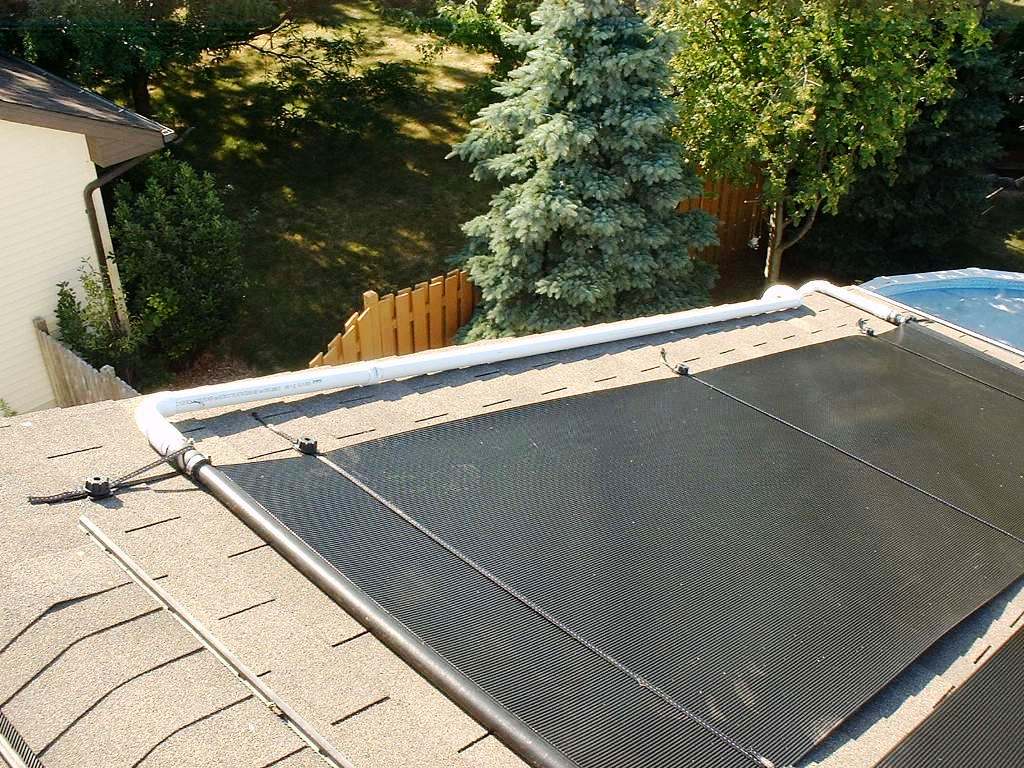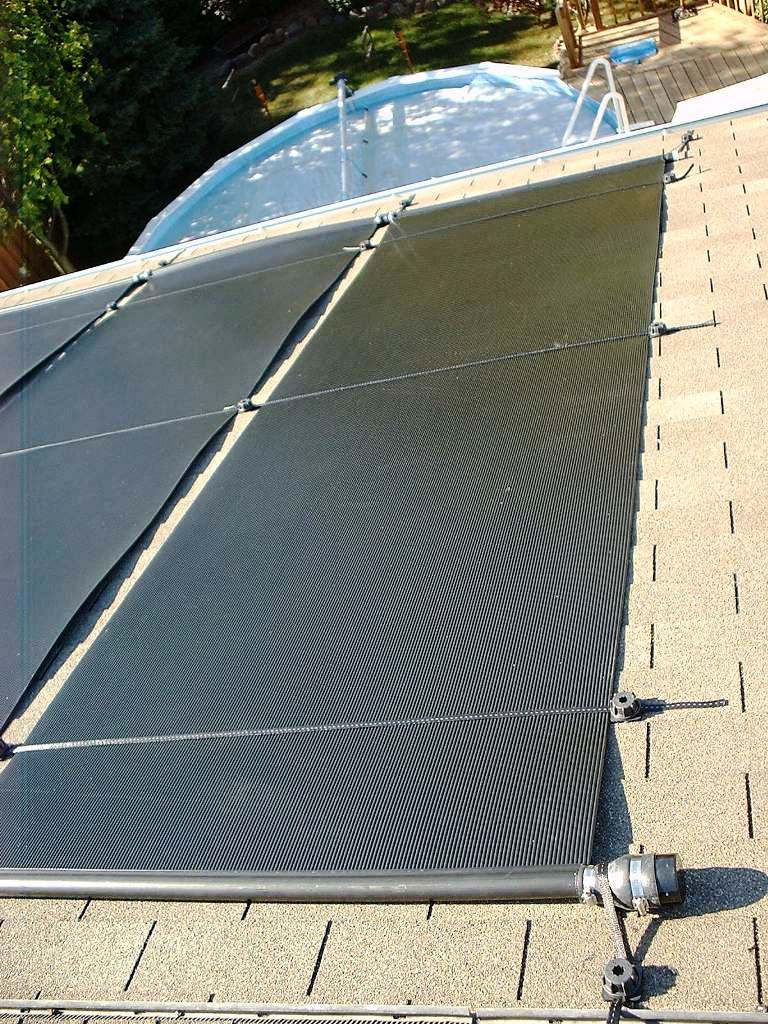
The 3 panels are 4'x12' vertically mounted "FAFCO/Sungrabber" units, totaling 144 sq. feet of collector surface, and are very efficient. The straps are used to hold the panels down in the wind. Follow the line of the shingles above the panels and you will see that the panels are mounted at a slight angle down towards the supply pipe side. This angled installation ensures complete drainage of the panels and piping when pressure is removed. Notice my neighbor's roof; solar panels need to be in full sun to be efficient...

The 1 1/2" PVC feeds the panels with cool water from the bottom and forces the water up (against gravity) to the top header where it has picked up the solar heat along the way. The warm water returns to the pool (actually, to the gas heater inlet) via the top PVC pipe. The gas heater doesn't run as long as it senses the warm water at the inlet. On hot, sunny Summer days, the 3 panels will take the pool water to 100 degrees if left on all day. This is why automated bypass valves are so important.

The vacuum relief valve (the VRV, lower right corner of the picture) allows the panels to drain when the system is bypassed.

The Solar Panels, being mounted on a 2nd floor roof, added additional "head pressure" to the pump so I upgraded to the unit shown in the picture. It is a 2 speed (notice the toggle switch on the pump motor) / 2 Hp. unit that runs at 3500 RPMs (very aggressive compared to the Doughboy 1 Hp. pump I was running) by day, and 1700 RPMs by night (virtually silent). I learned (through a Google search and much self-education) that you can't simply double the size of the pump without upgrading the filter size to a comparable GPM flow rate. The pump ran very "noisy" with the previous Doughboy Filter ahead of (and restricting) it. The Doughboy "Sequel I" filter couldn't handle the aggressive 80 GPM flow of the new pump and it actually became a "bottleneck" to the whole system, so I replaced it with a new Hayward Perflex EC75 unit (next picture) that easily handles the flow and increased head pressure. And the Hayward doesn't require backwashing! (you can see the "Bump" handle on the filter), I love it! The upper gate valve can be seen ahead of the outlet hose (right side of the filter), which I can close when I drain the dirty / regenerated D.E. powder out the bottom ball valve (visible as the white fitting, bottom side of filter picture). There is a matching gate valve at the filter's inlet port. The "safety type" single gang electrical outlet, just left of the filter, is a 20 amp / GFI home run to the breaker panel to support the new pump. The pump draws upwards of 17 amps in Hi mode, but only about 3.5 in Lo. Because we previously powered all the backyard tree lights, umbrella lights, pool lights and the Doughboy pump from the same 20 amp circuit, it was necessary to install the new 20 amp breaker just for the pump. The Solar Panel's 1-1/2" PVC supply and return piping is visible in the upper right corner of the picture.

The Hayward EC75 (Extended Cycle 75) D.E. filter is one of the new "No-Backwash" type filters and I'm very pleased with it's performance. The "Bump" handle on top , when activated, forces all the dirt and D.E. off of the elements inside the filter, only to be mixed with the dirt and reattached to the filter elements when the pump is turned back on. This saves pumping out still useable D.E. powder and a couple hundred gallons of warm, treated pool water every time the filter needs cleaning. The new style pressure gauge allows me to record the start-up pressure by turning the small black knob (center of the gauge) and aligning the Green pointer over the Black (actual pressure) pointer. As the D.E. becomes dirty, the tank pressure rises and the Black pointer eventually moves to the Red pointer, indicating a 10 pound pressure increase and time to "Bump" the D.E. again...

I ran the 2 PVC pipes up the side of the house using 20" long white cable ties strapped to the downspout. In this case (everything is white) they are barely noticeable. The angled pipe on the left is the supply pipe to the panels, the right/straight one is the return. Notice that the supply pipe is physically lower, and must remain the lowest point of the solar panel system to ensure proper drainage. The panels can stay up all Winter in Wisconsin; provided they are drained completely. Notice the "Party" speakers under the eaves of the Sun Room. They are angled/aimed towards the pool.